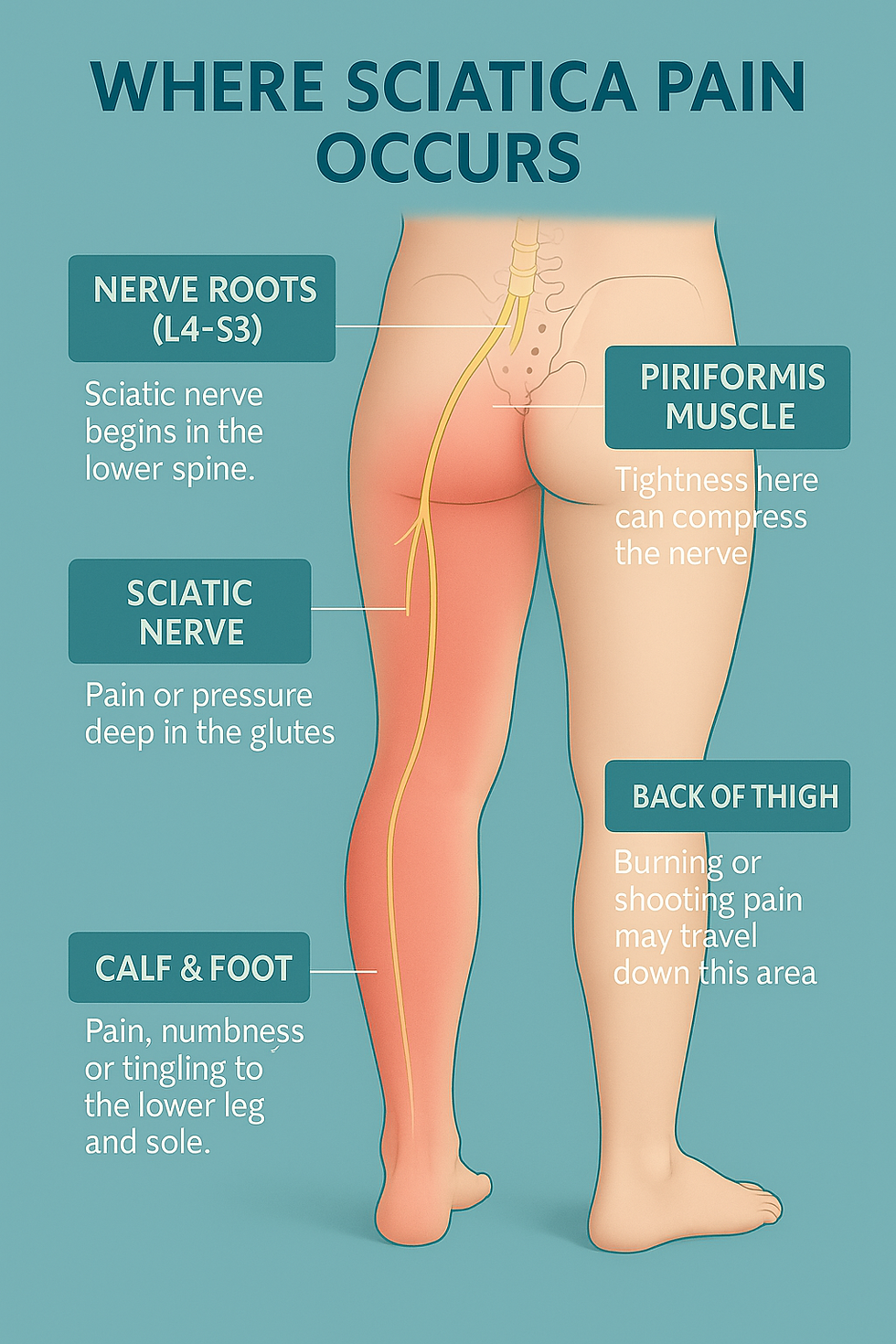Understanding Sciatica: How Massage Therapy Can Help Relieve Nerve Pain
- leefletcher814
- Oct 10
- 4 min read
Updated: Oct 11
What is sciatica?
Sciatica is nerve pain that travels from your lower back (lumbar spine) down your bottom and leg, sometimes right into the foot and toes. It can feel sharp, burning, tingling (pins and needles), or numb and may get worse when you cough or move suddenly. Most people improve within a few weeks to a few months, but it can be very uncomfortable while it lasts. Check the NHS for more info
Common signs you might recognise
Pain down the back of one leg (sometimes both).
Tingling, pins & needles or numbness.
Leg weakness or heaviness.
Pain that spikes with coughing/sneezing or certain movements. If you notice red-flag symptoms like changes to bladder/bowel control or numbness around the genitals or inner thighs, seek urgent medical advice. NHS inform
Why sciatica happens
Sciatica is usually caused by irritation or compression of the sciatic nerve as it leaves the spine. Triggers include a disc bulge, age-related changes, or tight/spasming tissues around the hips and lower back (hello, piriformis). The good news? Many cases settle with time, movement and the right support.
Where massage therapy can help 💆♂️
Massage doesn’t fix a disc, but it can help reduce muscle guarding, ease pain, improve local circulation and make movement feel more possible, so you can get back to gentle exercise sooner (which is key for a better outcome).
Evidence suggests massage can reduce low-back pain (including cases with radicular/leg pain), especially when it’s combined with exercise and education. UK guidance (NICE) recommends manual therapy - including massage - only as part of a package that includes exercise (and, where needed, psychological support). That’s exactly how I approach it at Indulge.

My approach at Indulge (what your session looks like)
In my Doncaster therapy room - with the heated couch, warm towels (which is very comforting at this time year) and a calming treatment (tailored to you) - I’ll...
Listen first: a focused chat to understand your pain pattern.
Targeted massage: gentle, pressure-aware techniques for the lower back, glutes and legs (including the piriformis and hamstrings) to dial down pain sensitivity and guarding.
Movement coaching: super-simple home moves to keep you improving between sessions.
Self-care plan: heat/ice advice, pacing tips and what to avoid temporarily (like prolonged slumping), plus when to speak to your GP.
I’m FHT-insured and can provide receipts for Health Shield/Bupa reimbursement schemes on request.
Simple movements that often feel good (and safe tips)
Short, frequent walks (even around the house).
Gentle back extensions (lying on your front then propping on elbows).
Nerve-friendly stretches that don’t crank the pain (e.g., easy knee-to-chest, only comfortable. See video links below for more).
⚠️ Skip high-impact, heavy twisting, or long periods of slumped sitting in the early phase if they aggravate your symptoms. Return gradually as things settle. (General caution, not a diagnosis.) Verywell Health
What the guidelines say (so you know you’re in safe hands)
NHS: Most sciatica improves with time; keep moving, use simple pain relief as advised, and seek urgent help for red flags.
NICE (UK): Consider manual therapy (including massage) only as part of a package with exercise (and psychological support where needed). NICE
Home self-care that pair
well with massage
Heat or ice (whichever feels better) for 10–15 minutes.
Activity pacing: little and often beats boom-and-bust days.
Sleep support: pillow between knees if side-lying.
Medication: follow NHS/GP advice about analgesics/anti-inflammatories if appropriate.
When to see your GP: if symptoms persist, worsen, or you develop any red flags mentioned above.
🎥 Helpful YouTube Videos for Sciatica Pain Relief
If you’re managing sciatica between massage sessions, gentle movement can make a huge difference. Here are a few safe, easy-to-follow routines I often recommend - all designed to reduce nerve tension, improve mobility and help your body relax more easily. 💚
🧘♂️ NHS Physiotherapy Exercises for Sciatica
▶ Watch - A physiotherapist from the NHS demonstrates clear, gentle exercises that can help ease sciatic pain caused by disc irritation.
🌿 5 Great Stretches for Instant Sciatica Pain Relief
▶ Watch - Five simple stretches you can do at home to loosen the hips, glutes and hamstrings - perfect if your pain worsens after sitting or driving. These movements pair beautifully with massage to help muscles release more deeply.
🧓 The Only 3 Exercises You Need for Sciatica (Ages 60+)
▶ Watch - Gentle, seated exercises designed for older adults or anyone who prefers low-impact movement. Great for keeping mobile and supporting long-term back health without over-stretching or straining.
💆♂️ Doctor Jo: Sciatic Nerve Pain Relief Stretches
▶ Watch - Doctor Jo’s calm, follow-along video shows easy stretches and nerve glides that reduce tension through the back and leg. Lovely to try in the evening after a warm bath or a massage session here at Indulge 🌿
💚 Combine these stretches with short walks, heat therapy and regular massage to keep your body moving freely and help prevent flare-ups.
Ready to feel more like you again?
If you’re in or around Doncaster, I’d love to help. I'll create a session plan that blends soothing, targeted massage, simple at-home moves and support and advice - all designed to calm symptoms and build confidence.
Your reset button is waiting 💚
Book online (choose Back, Neck & Shoulder with 'Sciatica focus' in notes) or message me with any questions.
See you soon,
Lee :)




Comments